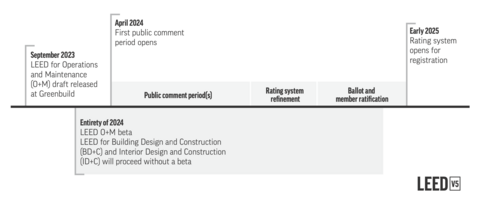Very informative blog post as always! I am wondering if all the changes will also affect LEED APs, since the credential came with knowledge of LEED v4. It would be logical to redo the exam for LEED v5 in my opinion, there are bigger differences now than there were between v3 and v4..
Blog Post
LEED v5: Catching up on Decarbonization, Equity, and Resilience
USGBC is commiting to this timeline for getting LEED v5 balloted and released for use. Sunset dates for LEED v4/4.1 are still to be determined.
It’s here. So what’s new?
The U.S. Green Building Council (USGBC) released LEED v5 for its first public comment period on April 3, 2024, giving us our first detailed look at the next generation of the program that has defined green building in North America and around the world for more than twenty years.
As we previewed last fall, a lot has changed since LEED v4 (and v4.1, which is the de facto current version, despite never having been balloted), including parts of the rating system structure and how the credits address climate change, social equity, and biodiversity.
The documents released today include scorecards, intent statements, and credit language for four rating systems:
SUPPORT INDEPENDENT SUSTAINABILITY REPORTING
BuildingGreen relies on our premium members, not on advertisers. Help make our work possible.
See membership options »- Building Operations + Maintenance: Existing Buildings (O+M, which has been out in pilot since last September)
- Building Design + Construction (BD+C): New Construction
- BD+C: Core & Shell
- Interior Design + Construction (ID+C): Commercial Interiors
USGBC plans to launch LEED v5 in 2025 and has promised updates on a five-year cycle thereafter.
You have until May 20 to comment on these rating systems, which you can do in USGBC’s LEED Credit Library or by accessing the dedicated forums we’ve set up for that purpose on LEEDuser.
Three goals: carbon, well-being, ecology
We covered the strategic organization behind the new version in our blog post “LEED v5 Preview #1: New Structure Hits All the Right Notes” and a series of related, linked posts. Every prereq and credit is now tagged with one or more of the “rating system goals”:
- Decarbonization
- Quality of life
- Ecological conservation and restoration
Carbon, climate resilience, and social equity assessments are now prerequisites for every project, and they show up throughout the credits as well. And although electrification is not required—except for Platinum-level certification in the design and construction rating systems—it is strongly encouraged in the point structure.
Notably, there is no longer one massive energy efficiency and carbon emissions credit—energy and carbon are now decoupled. It will now be easier to earn energy efficiency points without doing energy simulations for compliance, and measures to reduce operational and embodied carbon are rewarded separately.
Special Platinum requirements
Both O+M and the design and construction rating systems now have an entirely new element: LEED Platinum requirements.
That’s right: to achieve Platinum-level certification, it’s no longer enough to meet all the prerequisites and get to 80 points. You now also have to achieve a bundle of specific decarbonization thresholds.
For example, high levels of energy efficiency are now required across the board to hit Platinum, and design and construction projects have to be all-electric, include renewable energy, and reduce embodied carbon.
O+M has evolved: grid and prerequisites
We’ve already seen a “beta” version of O+M that was released last fall for a pilot program.
Even in that short time, significant changes have been made, such as doubling the number of points available in the Grid Interactive credit. This credit has advanced relatively rapidly in both O+M and BD+C: it was previously called Grid Harmonization in v4.1 and Demand Response in v4, where it included a narrower set of strategies. (For more background on grid interactivity in LEED, see our tip sheets “4 Steps to Demand Response: A Primer for Your LEED Project” and “Grid Harmonization: Using Buildings to Clean up the Grid.”)
Also, instead of a flock of prerequisites spread across the categories, most of them have been shepherded into an über-prereq that requires a broad set of policies and assessments. It’s called “Operations Assessment: Climate Action, Quality of Life, and Ecological Conservation and Restoration.”
New Construction: pilot credits graduate!
Some of the new credits, and new approaches to existing credits, in v5 BD+C are familiar to those who’ve been taking advantage of the pilot credit library: USGBC has leaned into the process of testing new credit concepts and then integrating some of them into the core rating systems.
- Bird-safe glass is finally integral to LEED—not as its own credit, but as part of a new Light-Pollution- and Bird-Collision-Reduction credit, which requires projects to address both issues to earn the point.
- Biophilia now has its own credit: Connecting with Nature. The requirements appear simpler than those of the biophilic design pilot credit, and the language references a classic text, The Practice of Biophilic Design, rather than the 14 patterns later established by Terrapin Bright Green. But teams have flexibility, provided their chosen biophilic attributes also fit into three prescribed categories and they hit the minimum of 12 attributes across those categories.
- Procurement of low-carbon construction materials is now Option 2 of three within a credit called Reduce Embodied Carbon. The credit offers six total points, and Option 2 is far simpler in the v5 draft than the pilot version of this credit was. There’s a laser focus on hotspots like concrete, steel, aluminum, and other carbon-intensive materials. This is where whole-building life-cycle assessment ended up (Option 1), along with environmental product declarations (Option 3), which is also hotspot-focused and references federal Buy Clean requirements established through the Inflation Reduction Act.
- Resilient design is now integrated across the rating system. These include the Climate Resilience Assessment prerequisite, Resilient Site Design (which sounds broader than it is since it only addresses flooding), Enhanced Resilient Site Design, and Resilient Spaces. Many of the fundamentals appeared in the original pilot credits on resilient design—since discontinued and then rebooted to address resilience planning, design, and passive survivability in new ways. The v5 drafts takes several new approaches, perhaps in part because we now have more standards to reference than the creators of the early pilot credits had.
- Grid Interactive has taken a much simpler approach than the complicated calculations in the GridOptimal Building Alternative Compliance Path pilot credit. It now leans into electrical and thermal storage, demand response, and power resilience.
Other popular pilot credits whose features appear in the v5 draft: Inclusive Design (in Occupant Experience as well as Enhanced Building Accessibility), All-Gender Restrooms (in Enhanced Building Accessibility), and the Safety First pilot credits (in Option 2 of the Resilient Spaces credit: Management Mode for Respiratory Diseases).
Materials innovations
The Materials & Resources category has gotten a major overhaul:
- Assessing embodied carbon from structural materials is now a prerequisite.
- Jobsite carbon emissions are now explicitly included in the Reduce Embodied Carbon credit, which replaces LEED v4’s Whole Building LCA credit—tracking those emissions is worth up to three of the eight available points.
- The Low-Emitting Materials credit didn’t change dramatically, but it has found a new home in the MR category.
- Products with certain certifications and declarations can now count toward a new Optimized Building Products credit. Products are assigned a score based on a matrix modeled on Mindful Materials’ Common Materials Framework, which builds on the five “buckets” of the A&D Materials Pledge created by The American Institute of Architects. These points are in addition to any points those same products might help the project earn through reduced embodied carbon and low indoor emissions.
What do you think?
LEED is definitely making major moves here. Has USGBC struck the right balance between leadership and achievability? This is your chance to weigh in!
As you do that, consider commenting on what you like about their choices, in addition to any concerns. USGBC staff and volunteers have been toiling on this for years, and it’s nice to show them some love. Plus, if they get pushback on something that you like, any positive comments will be factored into proposed changes. Finally, if you do have an issue with something in the system, your concern is more likely to be addressed if you include a specific suggestion on how to fix it.
You can do all of that on USGBC’s website, or start a conversation by commenting more publicly here on LEEDuser (yes, USGBC will officially review all comments posted in either location). The specific LEEDuser forums available for comments are:
- O&M Existing Buildings
- BD+C/ID+C: Overall and Appendix
- BD+C/ID+C: Integrative Process, Planning, And Assessments
- BD+C/ID+C: Location and Transportation
- BD+C/ID+C: Sustainable Sites
- BD+C/ID+C: Water Efficiency
- BD+C/ID+C: Energy and Atmosphere
- BD+C/ID+C: Materials and Resources
- BD+C/ID+C: Indoor Environmental Quality
- BD+C/ID+C: Project Priorities and Innovation
Published April 3, 2024 Permalink Citation
(2024, April 3). LEED v5: Catching up on Decarbonization, Equity, and Resilience. Retrieved from https://www.buildinggreen.com/blog/leed-v5-catching-decarbonization-equity-and-resilience




Add new comment
To post a comment, you need to register for a BuildingGreen Basic membership (free) or login to your existing profile.